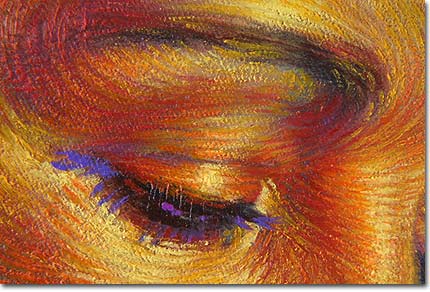Hatching and Red Series by Antoine Bridi
A- Hatches Series (Divisionism)

Poet inspiration (Detail)
• Optical Mix
- In the place of divisionism points, I apply the hatching technique to represent human flesh; the static effect created by Seurat or by Signac is thus transformed into interior vibration that shatters the mute silence of form. Hatching lines are juxtaposed side by side through the use of 12 pure colours that allow the viewer to experience a burst of movement.
• Reconciling the static and the dynamic
- The static pose of the model as well as the static geometry of the composition are betrayed by the palpitation of flesh under the influence of the hatching technique that caresses the entire body and gives shape to corporal anatomy itself. Dynamic energy emanates from the static as it echoes the internal sonority of the model.
• Hatching and painterly effect
- I overlay hatching in successive applications beginning from the darkest to the clearest in order to prepare the desired glow. The progression of overlay is not intended as value enhancement but rather as colour enhancement. Its source of inspiration is the metamorphosis of colour and of the chromatic circle to intensify the resulting painterly effect.
• Unusual Impression
- The colour flesh does not exist. The optical mix reconstitutes this colour from a distance which cannot be obtained by any other mix, whence the fantastic and phantasmagorical experience of the viewer.
• Interactivity
- As we move closer to the canvas, the vibration of the coloured hatching technique acquires progressive intensity. It is as though the body being represented casts its own hypnotic spell over the viewer. It is an attempt to translate into colour the mythical effect of sonority produced by the siren song that enchanted mariners.
B- Red Series (alla prima)

• Drawing and Painting
- These representations are a testimony to the reconciliation between drawing and painting, between line and colour. The Raphaelesque line, which at one time was used to give relief to graceful motion, is used here in a new function, which is to capture the interior agitation expressed by extended impasto applications – bringing new virtuosity to the construction of the anatomy – and through the use of energetic graphics that are in feverish communication with the body being represented, whence the apparent vibration of the contour generated by the tensions between the centrifugal and centripetal forces of the body.
- The flamboyance of the colour as well as the energy of the graphic lines combine to create an atmosphere of turbulence extending beyond the limits of the canvas as it invades the zone of the viewer.
• Diminishment of Glow (dominant seventh chord)
- The lighting never reaches its dominant –white–, which produces a luminous and chromatic effect on the sense of sight as the process is being accomplished (on the way to fulfillment). A similar effect is produced musically when the leading note of the half cadence suggests the finale without however achieving it. It is similar to leaving a question in suspension, the subjective answer to which is left suppressed in the field of the viewer.
- Coming back to the red series, the diminished lighting –yellow– seems to highlight an ecstasy which has not yet reached the threshold of orgasm.
• Framework Composing Light and Obscurity.
- Lighting is no longer conditioned by the source of the light, but is induced through the composition of light and sombre zones. The geometry thus becomes instable and its equilibrium can only be restored through the selective illumination of the zones. It is in this sense that we refer to the framework composing light and obscurity.